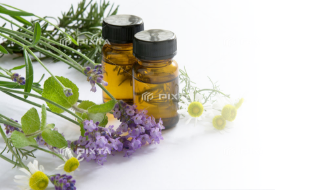 Ingredients for Products
Ingredients for Products

Functional food material
Rabitol (former name: Zigbertin)
-
Product name
Rabitol
-
Quantity
1kg
-
1.Comparison of antioxidant activity between Russian larch extract and coastal pine bark extract
Comparison of antioxidant activity between taxifolin-rich Russian pine extract and flavonoid-based polyphenol-containing coastal pine bark extract is based on their ability to suppress radical cations (ABTS · +) produced under model conditions. Evaluated.
Based on the results of evaluation tests on antioxidant activity using the radical cation ABTS ・ +, a taxifolin-rich Russian caramatsu extract (8.26 mmol) was compared with the coastal pine bark extract (5.14 mmol [trolox] / g [dry substance]). [Trolox] / g [Dry substance]) showed about 1.6 times the antioxidant activity.
This is thought to be due to the difference in the composition and content of flavonoid-based polyphenols contained in the bark of coastal pine trees.
-
2.Tyrosinase inhibitory activity test of Russian larch extract
As a measure against whitening and age spots, a substance that inhibits tyrosinase is required in order to suppress melanin production.Taxifolin, the main component of the Russian larch extract "Labitol", showed activity to inhibit tyrosinase in a concentration-dependent manner, but not flavonoids with a similar skeleton.Since rabitol inhibits tyrosinase, it was considered that it could be considered as a raw material for health foods that is good for cosmetology.

-
3.Research report in Russia (including pharmaceutical products)
Antioxidant / anti-aging effect
-
Mechanism of action / basis
By removing and inactivating free radicals, it prevents oxidation of cell membranes and protects all organs (skin). It also protects against DNA damage.
-
Disease
Aging / cancer
Capillary protection
-
Mechanism of action / basis
Increases the tightness of capillaries (reduces permeability) and suppresses exudation. (Leakage triggers inflammation) Exudation causes poor overall blood flow.
-
disease
Inflammatory disease, arteriosclerosis, cerebrovascular accident, bleeding from gums, bruise, hypertension
Anti-inflammatory / anti-allergic activity
-
Mechanism of action / basis
Inflammatory edema is suppressed even by forced infusion of histamine.Lipoxygenase (LTC4, LTD4, LTE4 produced by 5-lipoxygenase is mainly involved in bronchoconstriction, airway hyperresponsiveness, vascular permeability, and LTB4 is involved in leukocyte migration.
Therefore, it is suitable for various allergic diseases, asthma, rhinitis, cerebral infarction, myocardial infarction, etc. ) Also has an inhibitory activity. -
Disease
Relief of inflammation and allergic symptoms
Liver protection
-
Mechanism of action / basis
CCl4Confirmed suppression of increase in transaminase and alkaline phosphatase in injured rats. It is presumed to be due to antioxidant activity.
-
Disease
Liver disorder
Improvement of lipid metabolism
-
Mechanism of action / basis
A high-fat diet was administered to rats. Serum beta lipoproteins, TC, TG, and hepatic phospholipids are lower than the subject. In hepatocyte culture, it is presumed to be due to HMG-CoA reductase inhibition.In clinical practice, both TC and LDL decreased, and long-term administration to type II diabetic patients decreased total TC, LDL, TG and increased HDL,Confirmed decrease in malondialdehyde.It is thought that lipid peroxide can also be prevented.
Disease
Side effects of radiation therapy
Radiation protection characteristics
-
Mechanism of action / basis
Irradiate mice with 5 to 8 Gr, and confirm that they have a protective effect and improve survival rate. Decreased proportion of polychromasia (white blood cells are not reduced)
-
Disease
Side effects of radiation therapy
Suppression of platelet activity
-
Mechanism of action / basis
It is considered to suppress thromboxane synthesis.
-
Disease
Blood circulation disorder
Type II diabetic retinopathy
-
Mechanism of action / basis
Clinical trial: General improvement of lipid metabolism in the administration group and improvement of visual acuity by membrane stabilization
-
Disease
Diabetes symptoms
Patients with acute pneumonia
-
Mechanism of action / basis
Clinical trials:Recovery by X-ray diagnosis, reduction of pulmonary fibrosis, and improvement of aeration function index were observed.
-
Disease
Lung disease (bronchitis, etc.)
Brain protection properties
-
Mechanism of action / basis
Learning ability improved day by day in a labyrinth experiment using cerebral ischemic rats.No improvement in the non-administered group.The Θ wave asymmetry coefficient of the left brain with respect to the right brain improved to 0.71 in the treated group compared to 0.51 in the non-administered group.Improvements were also seen in neurons.Clinically, improvement was seen in patients with atherosclerosis.Improvements were also seen in short-term memory, attention, and thinking processes.
-
disease
Cerebral infarction etc.
Regarding gynecological diseases
-
Mechanism of action / basis
In patients treated for tick-mediated neurological infections (such as infertility and irregular menstruation), there was a decrease in malonaldehyde and an increase in catalase and glutathione peroxidase activity in the treated group.The number of normalized ovulation menstrual cycles increased. Recovery of reproductive function was observed in the treated group of patients who underwent laparoscopic surgery of the ovary by electrocoagulation.
-
Disease
Infectious diseases / gynecological diseases
For corporations content
Feel free to contact us for inquiries, document requests, etc.
Sakamoto Bio Co., Ltd.Inquiries
Accepting 24 hours a day, 365 days a year!
-



